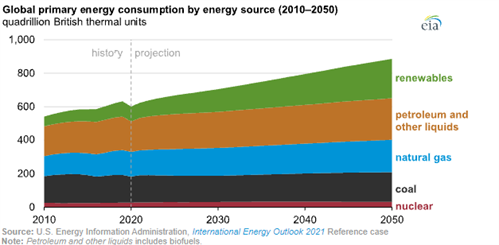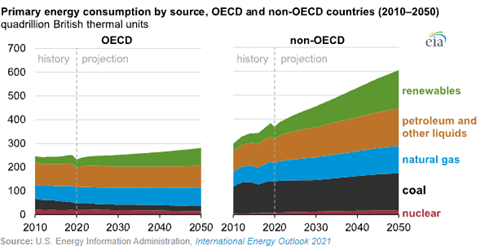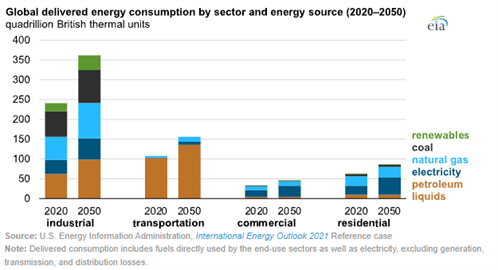EIA projects nearly 50% increase in world energy use by 2050

In the International Energy Outlook 2021 (IEO2021) Reference case, the EIA projects that, absent significant changes in policy or technology, global energy consumption will increase nearly 50% over the next 30 yrs. Although petroleum and other liquid fuels will remain the world’s largest energy source in 2050, renewable energy sources, which include solar and wind, will grow to nearly the same level.

Falling technology costs and government policies that provide incentives for renewables will lead to the growth of renewable electricity generation to meet growing electricity demand. As a result, renewables will be the fastest-growing energy source for both OECD and non-OECD countries. The EIA projects that coal and nuclear use will decrease in OECD countries, although the decrease will be more than offset by increased coal and nuclear use in non-OECD countries.
The EIA projects that global use of petroleum and other liquids will return to pre-pandemic (2019) levels by 2023, driven entirely by growth in non-OECD energy consumption. The EIA does not project OECD liquid fuel use to return to pre-pandemic levels at any point in the next 30 yrs, in part because of increased fuel efficiency.

The EIA projects that the industrial sector will increasingly consume petroleum liquids as feedstock in the expanding chemicals industry. In OECD countries, liquid fuel consumption in the industrial sector will grow three times as fast as liquid fuel consumption in the transportation sector.
Delivered electricity consumption will grow the most in the residential end-use sector. The EIA projects that in non-OECD countries, electricity will account for more than half of the energy used in households by 2050, compared with 33% in 2020. In non-OECD commercial buildings, the EIA projects that electricity will make up an even larger share of energy consumption in 2050, at 64%.
Globally, the EIA projects increased consumption of natural gas through 2050. The industrial sector is the main contributor to the growth in global natural gas consumption through 2050 in the EIA's Reference case, largely in non-OECD countries. Across OECD countries, gains in energy efficiency will reduce household natural gas use by 2050. The industrial sector will use the largest share of both natural gas and coal among all end-use sectors. Industrial coal use will expand fastest in non-OECD countries, where energy-intensive industries such as iron and steel production are expanding more quickly than in OECD countries.
Principal contributor: Courtney Sourmehi






Comments